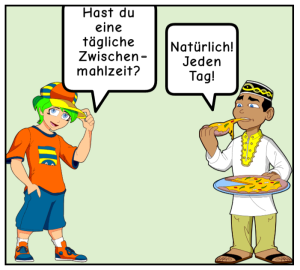6.7 Abwarten und Tee trinken

Guten Tag!
Zum Aufwärmen machen wir unseren Tagesminiplausch und eine Wiederholung.
Wiederholung
In the previous lesson, you learned about the ends and outs of die kalte Mahlzeit. Let’s review what you have learned.
What types of foods might you eat for die kalte Mahlzeit? In a complete sentence, write the foods you might eat. Be as specific as you can with the vocabulary you have learned thus far.
Lektionsüberblick
In Deutsch im Alltag I, you learned about die Zwischenmahlzeit in Germany, that in-between meal that is enjoyable to share with friends, co-workers, or classmates but also helps us have nourishment during a long day. We will review some about die Zwischenmahlzeit during this lesson. In the end, you will be able to 1) talk about the frequency of having a Zwischenmahlzeit, 2) respond to an invitation to coffee, and 3) ask someone to coffee.
Was weißt du schon?
Let’s see what you remember about die Zwischenmahlzeit. Let’s do a quick skills check.
| Noch nicht start klar?
Du kannst immer auf die gleiche 1010-Lektion zurückgreifen! |
Not confident about starting this lesson?
You can always review the same Lektion from 1010. |
1) Eine tägliche Zwischenmahlzeit?
You might recall that the most common Zwischenmahlzeit in Germany is Kaffeetrinken or Teestunde/Teetrinken in the mid-afternoon. Broadly speaking, Kaffeetrinken happens more in the south and Teestunde in the north. Funnily enough, you can hear people all over Germany refer to Kaffeetrinken even if tea – and not coffee – is being served! If you have been invited to Kaffee or Tee, you will generally be offered one or more baked goods with your drink.
The other kinds of Zwischenmahlzeiten are more typically rooted in specific settings and would be referred to in the US as snack times. For example, children will often have a Brotzeit or Vesper in school mid-morning, between breakfast and lunch. You may also find Brotzeit/Vesper on construction sites and in other settings, where the work begins early in the morning, making the time between breakfast and lunch long. The terms Brotzeit or Vesper are generally regional and consist of non-sweet food items like a belegtes Brötchen or Brot (a kind of sandwich made on a bread roll or bread with butter and cold cuts). Privately, people may also refer to these kinds of in-between meals with word Snack or Imbiss
Note: Imbiss can also refer to a stand where fast food and snacks are served.
At Zwischenmahlzeit, there is a snack to satisfy those with a sweet tooth and those who crave savory items. Click through the presentation below to see snacks that are sweet (süßig) and those that are savory (herzhaft). What sounds good to you? Listen and repeat.
You’ve learned the words to describe the frequency with which you do something (think: oft, manchmal, nie, selten, immer). Let’s add a new one to your vocabulary: täglich. See if you can guess the meaning in the comic below. Answer the question that follows.
 |
|
Jetzt bist du dran!
2) Zum Kaffee eingeladen werden (being invited to coffee)
Have you ever been invited out for coffee or tea by a friend? How did that conversation go? It’s quite similar in German. Listen and read the different ways someone might invite another, along with some responses. How would you respond? Choose your response.
|
 |
|
Jetzt bist du dran!
Hamburg im Blickpunkt

Das Hamburger Rathaus wurde zwischen 1886-1897 im Baustil Neorenaissance gebaut. Die Bau kostete damals 11 Millionen Goldmark (heute ca. EUR 80 Millionen). Das Gebäude ist fast so breit (111m) wie es hoch ist (112m). Die Fassade ist aus Granit und Sandstein und das Dach ist aus Kupfer. Das Rathaus hat 647 Räume und eine Grundfläche von 7.840m2.
The Hamburg City Hall was built between 1886 and 1897 in the Neo-Renaissance style. The construction cost 11 million Goldmarks at the time (today approx. EUR 80 million). The building is almost as wide (111m; 364ft) as it is tall (112m; 367ft). The façade is made of granite and sandstone, and the roof is made of copper. The city hall has 647 rooms and a floor area of 7,840m² (84,389ft2).
3) Zum Kaffee einladen
Read and listen again to the invitations to coffee. If you were to invite a classmate or friend, which invitation would you choose to use?
 |
Wollen wir uns auf einen Kaffee treffen? | |
| Sollen wir einen Kaffee trinken? | ||
| Ich möchte dich zum Kaffeetrinken einladen. |
Let’s practice.
Jetzt bist du dran!
Zum Schluß


*As you conclude this lesson, don’t forget to check Canvas!*

Media Attributions
- 1020-banner-large-reduced
- Comic made at www.MakeBeliefsComix.com
- Photo of man and woman by pexels-mikhail-nilov-7582642
- Photo of coffee cup by pexels-frank-leuderalbert-2939961-9188612

